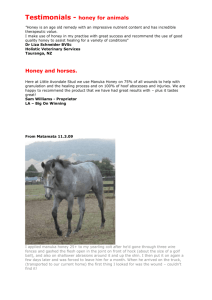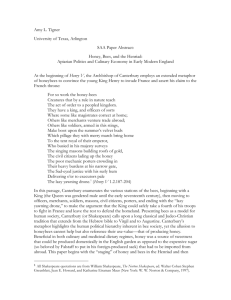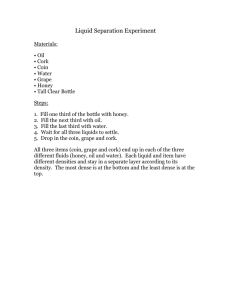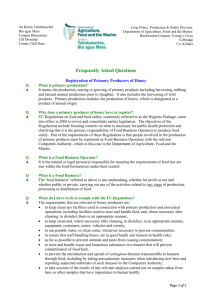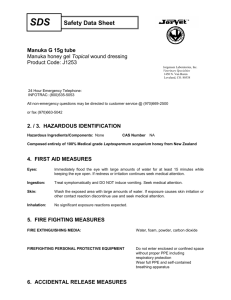Dietary phosphorus supplementation induces increased bone
advertisement
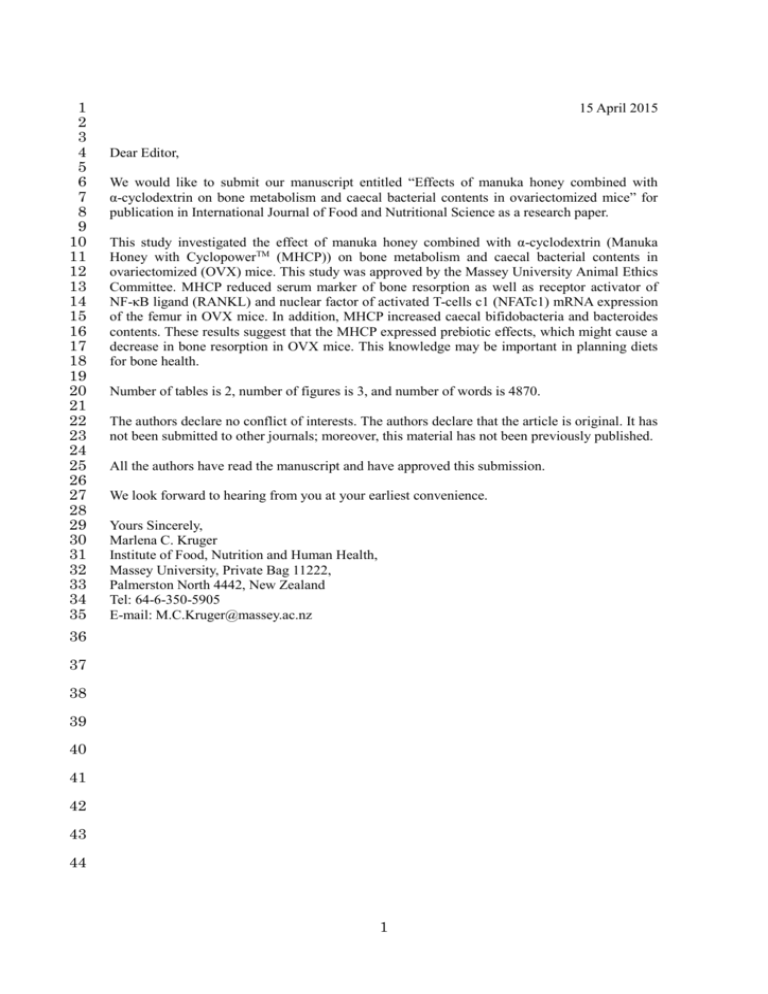
1 2 3 4 5 6 7 8 9 10 11 12 13 14 15 16 17 18 19 20 21 22 23 24 25 26 27 28 29 30 31 32 33 34 35 15 April 2015 Dear Editor, We would like to submit our manuscript entitled “Effects of manuka honey combined with α-cyclodextrin on bone metabolism and caecal bacterial contents in ovariectomized mice” for publication in International Journal of Food and Nutritional Science as a research paper. This study investigated the effect of manuka honey combined with α-cyclodextrin (Manuka Honey with CyclopowerTM (MHCP)) on bone metabolism and caecal bacterial contents in ovariectomized (OVX) mice. This study was approved by the Massey University Animal Ethics Committee. MHCP reduced serum marker of bone resorption as well as receptor activator of NF-κB ligand (RANKL) and nuclear factor of activated T-cells c1 (NFATc1) mRNA expression of the femur in OVX mice. In addition, MHCP increased caecal bifidobacteria and bacteroides contents. These results suggest that the MHCP expressed prebiotic effects, which might cause a decrease in bone resorption in OVX mice. This knowledge may be important in planning diets for bone health. Number of tables is 2, number of figures is 3, and number of words is 4870. The authors declare no conflict of interests. The authors declare that the article is original. It has not been submitted to other journals; moreover, this material has not been previously published. All the authors have read the manuscript and have approved this submission. We look forward to hearing from you at your earliest convenience. Yours Sincerely, Marlena C. Kruger Institute of Food, Nutrition and Human Health, Massey University, Private Bag 11222, Palmerston North 4442, New Zealand Tel: 64-6-350-5905 E-mail: M.C.Kruger@massey.ac.nz 36 37 38 39 40 41 42 43 44 1 46 Effects of Manuka Honey Combined with α-Cyclodextrin on Bone Metabolism and Caecal Bacterial Contents in 47 Ovariectomized Mice 45 48 49 Shinichi Katsumata 50 3 1,2 , Frances M. Wolber 1, Miki Tadaishi 2,3 , Yuko Tousen 3, Yoshiko Ishimi and Marlena C. Kruger 1,* 51 52 1 53 Zealand 54 2 55 Agriculture, Tokyo, Japan 56 3 57 Japan Institute of Food, Nutrition and Human Health, Massey University, Palmerston North, New Department of Nutritional Science, Faculty of Applied Bioscience, Tokyo University of Department of Food Function and Labeling, National Institute of Health and Nutrition, Tokyo, 58 59 Corresponding author: Marlena C. Kruger, Institute of Food, Nutrition and Human Health, 60 Massey University, Private Bag 11222, Palmerston North 4442, New Zealand, Tel: 61 +64-6-350-5905; Fax: +64-6-350-5446; E-mail: M.C.Kruger@massey.ac.nz 62 63 64 65 66 67 68 69 70 71 72 2 73 Abstract 74 Honey has antimicrobial, antitumor, antioxidant, and anti-inflammatory effects. However, there 75 have been few studies regarding the effects of manuka honey on bone metabolism and gut 76 microflora. This study investigated the effects of manuka honey combined with α-cyclodextrin, 77 Manuka Honey with CyclopowerTM (MHCP) on bone metabolism and caecal bacterial contents 78 in ovariectomized (OVX) mice. Seven-week-old female Balb/c-strain mice were divided into 79 four groups: sham-operated (sham) group, OVX group, and OVX mice that were fed a diet 80 containing 5% or 10% (w/w) MHCP. After 9 weeks, the mice were sacrificed, and serum, uterus, 81 caecum, and femur samples were obtained. Successful removal of the ovaries and induction of 82 the osteoporotic process in OVX mice were demonstrated by a significant decrease in uterine 83 weight and a significant increase in receptor activator of NF-κB ligand (RANKL) mRNA 84 expression of the femur, compared to sham, respectively. Compared to the OVX group, MHCP 85 reduced serum C-terminal telopeptide of type Ι collagen concentration as well as RANKL and 86 nuclear factor of activated T-cells c1 (NFATc1) mRNA expression of the femur. Furthermore, 87 MHCP increased caecal bifidobacteria and bacteroides contents. These results suggest that the 88 MHCP expressed prebiotic effects, which might reduce bone resorption in OVX mice. 89 90 Keywords: Manuka Honey with CyclopowerTM; Bone resorption; Receptor activator of NF-κB 91 ligand; Caecal bacterial contents; Ovariectomized mice 92 93 94 95 96 97 98 99 100 3 101 Introduction 102 Honey is a natural food product and mainly consists of several sugars. Moreover, it also 103 contains food factors such as proteins, vitamins, minerals, and polyphenols[1]. Previous studies 104 have shown that honey has antimicrobial, antitumor, antioxidant, and anti-inflammatory 105 effects[2]. In addition, a previous study demonstrated that honey intake caused significant 106 reduction of body mass index (BMI) and fasting blood glucose in overweight and obese subjects, 107 and significantly reduced serum triglyceride and C-reactive protein (CRP) in the subjects with 108 elevated variables[3]. Therefore, honey is expected to have several benefits for human health 109 possibly including an effect on bone health. 110 A previous study has shown that administration of honey for 2 weeks to ovariectomized 111 (OVX) rats restored the morphology of the tibia bones[4]. In addition, honey improved the 112 trabecular structure of bone as assessed using histomorphometry in OVX rats that were orally 113 gavaged daily for 6 weeks[5]. Thus, honey may prevent bone loss due to menopause. 114 Furthermore, honey enhanced the endogenous colonic probiotic bacteria in mice [6], which 115 indicates that honey may act as a prebiotic in the large intestine. 116 Cyclodextrin has been used as excipient for the delivery of hydrophobic drugs and 117 improving water solubility and stability[7]. Recently, manuka honey combined with 118 α-cyclodextrin (Manuka Honey with CyclopowerTM (MHCP)) has been produced and tested. 119 The results showed that MHCP retained antibacterial activity, and enhanced bacteriostatic and 120 possibly bactericidal activity against Gram-negative and Gram-positive pathogens[8]. Manuka 121 honey is a well known product of New Zealand, and contains high amounts of methylglyoxal 122 (MGO). MGO acts as a bioactive compound which is responsible for the antibacterial activity[9]. 123 It was reported that manuka honey had a potent inhibitory activity against the influenza virus [10]. 124 However, there have been few studies regarding the effects of manuka honey on bone 125 metabolism and gut microflora, whereas some studies were conducted by using other species of 126 honey as stated above[4-6]. Therefore, this study investigated the effects of MHCP on bone 127 metabolism and caecal bacterial contents in OVX mice. 128 4 129 130 Methods This study was approved by the Massey University Animal Ethics Committee (approval 131 number 13/38). 132 Experimental design 133 Five-week old female Balb/c mice were purchased from the Vernon Jenson Unit (VJU, 134 University of Auckland, Auckland, New Zealand) and housed 2-3 mice per plastic cage at 22 °C 135 with a 12-h light/dark cycle in a dedicated room. Throughout the study period, the mice were 136 fed their allocated control diet, 5% honey diet, or 10% honey diet, as shown in Table 1. Manuka 137 Honey with CycloPowerTM (MHCP, Manuka Health New Zealand Ltd, Auckland, New Zealand) 138 was used in this study. It is manufactured by combining MGO400+ manuka honey and 139 α-cyclodextrin, which is 45% honey solids plus 55% α-cyclodextrin[8]. MGO400+ manuka 140 honey has MGO level of 400 mg/kg or greater. All mice were fed the control diet for 2 week of 141 acclimatization period. After 2 weeks, 7-week-old mice were sham-operated (sham) or OVX. 142 Sham mice were fed the control diet. OVX mice were divided into three groups: one OVX 143 group was fed the control diet and the two remaining OVX groups received the 5% or 10% 144 honey diet. All mice were given free access to their respective diets and deionized water for 9 145 weeks. At the end of the study period, all mice were sacrificed, and the blood, uterus, caecum, 146 and femur samples were obtained for further analyses. The uterus, caecum, and caecal contents 147 were weighed. 148 Dual-energy X-ray absorptiometry (DXA) scans 149 At weeks 4 and 8, all mice underwent in vivo DXA scanning under anesthesia. Bone 150 mineral content (BMC), bone mineral density (BMD), and body fat were measured with a 151 Hologic Discovery A bone densitometer (Hologic Inc., MA, USA). Each mouse underwent a 152 high-resolution scan of the whole body. 153 Measurement of markers of bone turnover 154 The blood samples were centrifuged at 3000×g for 15 minutes and the serum 155 supernatants were stored at –80 °C until further analyses. Serum osteocalcin concentration was 156 measured using the Mouse Gla-Osteocalcin High Sensitive EIA Kit (Takara Bio Inc., Shiga, 5 157 Japan). Serum C-terminal telopeptide of type Ι collagen (CTx) concentration was measured 158 using RatLaps EIA (Immunodiagnostics systems, Boldon, UK). 159 Total RNA extraction and real-time reverse transcription-polymerase chain reaction 160 (RT-PCR) analysis of mRNA expression 161 The right femur was removed and cleansed of all soft tissues and was frozen at –80 °C 162 until further analysis. Frozen right femur was homogenized in 1.6 ml TRIzol reagent (Life 163 Technologies, CA, USA) using the Precellys homogenizer in tubes containing ceramic 2.8 mm 164 beads and one 5 mm zinc oxide bead (Precellys) at 6500 rpm for 20 seconds. Total RNA was 165 isolated from the lysate by using Direct-zol RNA MiniPrep kit (Zymo Research, CA, USA) 166 according to the manufacturer's instructions. The cDNA was synthesized using the SuperScript 167 III First-Strand Synthesis SuperMix for qRT-PCR (Life Technologies) and was subjected to 168 quantitative real-time RT-PCR using SYBR Select Master Mix (Life Technologies). Specific 169 primers[12,13] were used for the analysis of receptor activator of NF-κB ligand (RANKL) 170 (forward, 171 5’-CCACAATGTGTTGCAGTTCC-3’), nuclear factor of activated T-cells c1 (NFATc1) 172 (forward, 173 5’-TGTGGGATGTGAACTCGGAA-3’), 174 5’-TGACAGGATGCAGAAGGAGA-3’; 175 Real-time RT-PCR was performed on a LightCycler 480 System (Roche, Mannheim, Germany). 176 The mRNA expression was normalized to β-actin mRNA as a housekeeping gene. 177 DNA extraction and bacteria quantification by real-time PCR 5’-TGAAGACACACTACCTGACTCCTG-3’; 5’-CCGTGCTTCCAGAAAATAACA-3’; and reverse, β-actin reverse, reverse, (forward, 5’-CGCTCAGGAGGAGCAATG-3’). 178 Caecal contents were removed and frozen at –80 °C until further analysis. The DNA 179 was extracted from the caecal contents by using ISOLATE Fecal DNA kit (Bioline, London, 180 UK) according to the manufacturer's instructions. To quantify lactobacillus, bifidobacteria, and 181 bacteroides, the specific primers[14-16] were used for the analysis of lactobacillus (forward, 182 5’-GGAAACAGRTGCTAATACCG-3’; reverse, 5’-ATCGTATTACCGCGGCTGCTGGCA-3’), 183 bifidobacteria 184 5’-CCACATCCAGCRTCCAC-3’), (forward, 5’-TCGCGTCYGGTGTGAAAG-3’; and 6 bacteroides reverse, (forward, 185 5’-GAGAGGAAGGTCCCCCAC-3’; reverse, 5’-CGCTACTTGGCTGGTTCAG-3’). Real-time 186 PCR was performed on a LightCycler 480 System (Roche). The PCR reaction was performed 187 using the LightCycler 480 SYBR Green Ι Master (Roche). 188 Statistical analysis 189 Results were expressed as mean ± standard error of the mean (SEM). Data were 190 analyzed by one-way analysis of variance (ANOVA), followed by Tukey’s post hoc testing. 191 Differences were considered to be significant when the p value was less than 0.05. Statistical 192 analysis was performed using SPSS statistics ver. 21 (IBM, IL, USA). 193 194 Results 195 Body weight and uterine weight 196 Initial and final body weights did not differ significantly among the four groups (Table 197 2). Body weight gain was significantly higher in the OVX group than in the sham group, 198 whereas there was no significant difference in body weight gain between the OVX and 5% or 199 10% honey groups. Uterine weight was significantly lower in the OVX group than in the sham 200 group. The 5% and 10% honey diet did not affect uterine weight in the OVX mice. 201 BMC, BMD, and fat of whole body 202 At weeks 4 and 8, BMC and BMD of the whole body did not differ significantly 203 between the sham and OVX groups and between the OVX and 5% or 10% honey groups (data 204 not shown). At week 4, there was no significant difference in body fat percentage among the 205 four groups (Table 2). Whole body fat content did not differ significantly between the sham and 206 OVX groups and was significantly lower in the 10% honey group than in the OVX group at 207 week 4. At week 8, there were no significant differences in whole body fat content and body fat 208 percentage among the four groups. 209 Markers of bone turnover 210 Serum osteocalcin concentration did not differ significantly among the four groups 211 (Figure 1). Serum CTx concentration did not differ significantly between the sham and OVX 212 groups. Compared to the OVX group, the 5% honey diet tended to decrease (p=0.06) and the 7 213 10% honey diet significantly decreased (p<0.05) serum CTx concentration. 214 RANKL and NFATc1 mRNA expression of the femur 215 RANKL mRNA expression of the femur was significantly higher in the OVX group 216 than in the sham group (Figure 2). Compared to the OVX group, the 5% and 10% honey diets 217 significantly decreased RANKL mRNA expression of the femur. NFATc1 mRNA expression of 218 the femur was significantly lower in the 5% and 10% honey groups than in the OVX group, 219 whereas there was no significant difference in NFATc1 mRNA expression of the femur between 220 the sham and OVX groups. 221 Caecum weight and caecal bacterial contents 222 There were no significant differences in the caecal organ weight among the four groups 223 (Table 1). The weight of caecal contents did not differ significantly between the sham and OVX 224 groups but was significantly higher in the 5% and 10% honey groups compared to the OVX 225 group. 226 There was no significantly difference in lactobacillus content among the four groups 227 (Figure 3). Bifidobacteria content did not differ significantly between the sham and OVX 228 groups but was significantly higher in the 10% honey group than in the OVX group. 229 Bacteroides content did not differ significantly between the sham and OVX groups but was 230 significantly higher in the 5% and 10% honey groups than in the OVX group. 231 232 Discussion 233 In this study, serum CTx concentration was increased by about 13 % in the OVX group 234 compared to the sham group, although this was not statistically significant. However, RANKL 235 mRNA expression of the femur was significantly higher in the OVX group than in the sham 236 group. RANKL is an osteoclast differentiation factor and plays a key role in osteoclastic bone 237 resorption[17]. Therefore, the results suggest that ovariectomy caused an increase in osteoclast 238 differentiation in this study. Uterine weight decreases following total ovariectomy, and body 239 weight gain increases in OVX animals. Weight gain, as well as development of osteoporosis, is 240 a concern for women following menopause. In this study, the uterine weights of OVX group 8 241 were reduced and the rate of gain of body weight increased compared to the sham group. Taken 242 together, these findings show that this model successfully induced early osteoporotic 243 pathogenesis. 244 Previous studies showed that tualang honey improved the trabecular structure of bone in 245 OVX rats[4,5]. We used MHCP in this study, and the 5% honey diet tended to decrease (p=0.06) 246 and the 10% honey diet significantly decreased serum CTx concentration in OVX mice without 247 a change in uterine weight. Furthermore, RANKL and NFATc1 mRNA expression of the femur 248 were significantly lower in the 5% and 10% honey groups than in the OVX group. It is known 249 that NFATc1 mediates osteoclast differentiation as a key regulator responsive to RANKL [18]. 250 RANKL induces TNF receptor-associated factor 6 (TRAF6) and c-Fos expression during 251 osteoclastogenesis and the pathways related these molecules play important roles in NFATc1 252 expression. Therefore, MHCP may inhibit RANKL mRNA expression, which leads to a 253 decrease in NFATc1 mRNA expression. Further studies may be needed to investigate the 254 changes in molecules that are related with RANKL-NFATc1 signal pathway, such as TRAF6 255 and c-Fos. Osteoprotegerin (OPG) is known as a decoy receptor for RANKL and is also an 256 important factor for osteoclastogenesis[19]. We did not measure OPG mRNA expression of the 257 femur in this study, but a recent study showed that ovariectomy increased serum RANKL 258 concentration but did not change serum OPG concentration in rats[20]. However, the effect of 259 MHCP on OPG mRNA expression remains unknown, and further studies are necessary for 260 clarification. These results suggest that MHCP inhibited RANKL-induced osteoclast 261 differentiation, which led to a decrease in bone resorption in OVX mice. 262 In this study, there were no significant differences in BMC and BMD of the whole body 263 between the sham and OVX groups and between the OVX and 5% or 10% honey groups as 264 measured by DXA scanning, whereas uterine weight was significantly lower in the OVX group 265 than in the sham group. The measurement using the DXA machine was possibly not sensitive 266 enough to detect any differences in BMC and BMD. For mice, other instruments are usually 267 used. Also in general, trabecular bone is more affected than cortical bone by ovariectomy. A 268 previous study showed that ovariectomy caused a decrease in trabecular bone volume of the 9 269 distal femur and an increase in RANKL mRNA expression of bone marrow cells from the tibia, 270 whereas there was no significant difference in whole femur BMD[21]. It may be of benefit to 271 rather measure the trabecular bone volume by bone histomorphometry or μCT in the further 272 studies with mice. Furthermore, body weight gain was significantly higher in the OVX group 273 than in the sham group in this study. Therefore, an increase in body weight gain might have 274 influenced BMD in the OVX group. 275 Honey is rich in polyphenols, and quercetin and kaempherol are found in honey[1]. 276 However, the type and concentration of these compounds are known to vary depending on 277 geographical location and floral source. Manuka honey produced in New Zealand contains large 278 amount of quercetin and kaempherol as with other species of honey[22]. Previous studies 279 reported that quercetin inhibited a decrease in BMD in OVX mice, and quercetin suppressed the 280 RANKL-induced NFATc1 expression and osteoclast formation in RAW264.7 cells[23]. Likewise, 281 kaempherol inhibited interleukin-1β-stimulated, RANKL-mediated osteoclastogenesis via 282 downregulation of NFATc1 in mouse bone marrow cells[24]. In addition, manuka honey is also 283 rich in luteolin[22], which has a preventive effect of OVX-induced bone loss and inhibition of 284 osteoclast formation in RAW264.7 cells[25]. Thus, polyphenols such as quercetin, kaempherol, 285 and luteolin in the manuka honey could also have contributed to suppression of bone resorption 286 in OVX mice. High concentration of MGO is characteristic in the manuka honey, and MGO 287 contributes to the antibacterial activity[9]. However, there are no studies about the effects of 288 MGO on bone metabolism, and detailed examinations are necessary to clarify. 289 Prebiotics such as fructooligosaccharides have been found to increase the numbers of 290 bifidobacterium and lactobacillus in rats[26]. Fermentation in the large intestine produces short 291 chain fatty acids (SCFAs) and other organic acids that contribute to lower luminal pH in the 292 large intestine which, in turn, elicits a modification of calcium solubility in the luminal phase so 293 that its passive diffusion is improved[27]. In addition, SCFAs are also likely to contribute directly 294 to the enhancement of calcium absorption[28]. Thus, prebiotics such as oligosaccharides have 295 been found to stimulate calcium absorption, which have a beneficial effect on bone health. A 296 previous study has shown that cotton honey enhanced the endogenous colonic probiotic bacteria 10 297 in mice[6]. In this study, the weight of caecal contents was significantly higher in the 5% and 298 10% honey groups than in the OVX group, whereas caecal organ weight did not differ. 299 Furthermore, caecal bifidobacteria content was significantly higher in the 10% honey group 300 than in the OVX group, and caecal bacteroides content was significantly higher in the 5% and 301 10% honey groups than in the OVX group. These results suggest that MHCP enhanced caecal 302 probiotic bacteria. It is well known that honey contains oligosaccharides like as 303 fructooligosaccharide, and manuka honey also contains oligosaccharides[29]. Therefore, we 304 speculate that oligosaccharides in the MHCP expressed a prebiotic effect, which may have a 305 beneficial effect on bone resorption in OVX mice. Furthermore, acute feeding of honey and its 306 carbohydrate constitutions (glucose, fructose, and raffinose) enhanced calcium absorption in 307 rats[30]. Thus, carbohydrate constitutions of the MHCP might also have increased calcium 308 absorption in this study. 309 Cyclodextrin have been used as excipients for the delivery of hydrophobic drugs and 310 improving water solubility and stability[7]. Since cyclodextrin is a non-digestible sugar, 311 fermentation in the large intestine may have occurred in this study. In fact, 5% α-cyclodextrin in 312 the diet increased weights of caecal tissue and caecal contents and amount of caecal organic 313 acids contents in rats[31]. α-Cyclodextrin may therefore stimulate caecal fermentation, leading to 314 an increase in caecal organic acids contents. MHCP used in this study contains 55% 315 α-cyclodextrin[8], and the percentage of α-cyclodextrin in the 10% honey diet was 5.5% in this 316 study. Therefore, oligosaccharides as well as α-cyclodextrin may have influenced caecal 317 bacterial contents. 318 In this study, 10% honey diet significantly decreased whole body fat content at week 4 319 in OVX mice, although there is no significant difference in body weight at week 4 between the 320 OVX (26.9 ± 1.6 g) and 10% honey (24.9 ± 0.9 g) groups. A previous study demonstrated that 321 mean total percent body fat was lower in honey-fed rats than in sucrose-fed rats without change 322 in food intake[32]. The mechanism by which honey reduced body fat is not still clear, but 323 polyphenols and oligosaccharide in the honey might influence whole body fat content. 324 Quercetin reduced fat accumulation in mice with high fat diet-induced obesity[33]. Furthermore, 11 325 fructooligosaccharide increased the bioavailability of quercetin, which augmented benefits of 326 quercetin in sucrose-fed rats[34]. Thus, polyphenols and oligosaccharides in the MHCP may have 327 decreased whole body fat content of the OVX mice in this study. 328 The presented study has some weakness: The actual chemical composition of the 329 MHCP used in this study was not analysed and the specific effects of manuka honey without 330 α-cyclodextrin was not tested. A previous study showed that the MHCP maintained anti-oxidant 331 capacity and increased anti-inflammatory effect compared to manuka honey that has a MGO 332 level of 400 mg/kg or greater[35]. Also, a further study demonstrated that manuka honey was an 333 effective antibacterial agent that can be enhanced by complexing with α-cyclodextrin[8]. Thus, it 334 is possible that inclusion of manuka honey in α-cyclodextrin maintains or promotes the effects 335 of manuka honey. We can therefore not explain which component in the honey could have had 336 the significant effect and further research is required to investigate the selective effects of 337 manuka honey in the presence and absence of α-cyclodextrin. 338 339 Conclusion 340 We demonstrated the effects of MHCP on bone metabolism and caecal bacterial 341 contents in OVX mice. MHCP decreased serum CTx concentration and femoral RANKL and 342 NFATc1 mRNA expression without any effect on uterine weight in OVX mice. In addition, 343 MHCP increased caecal bifidobacteria and bacteroides contents. These results suggested that the 344 MHCP expressed prebiotic effects, which may have caused a decrease in bone resorption in 345 OVX mice. 346 347 348 Conflicts of interest The authors declare no conflicts of interest. 349 350 Acknowledgements 351 This study was funded by New Zealand (Minister of Business, Innovation and 352 Employment) and Japan (Japanese Science and Technology Agency) of the Strategic Bilateral 12 353 Agreement Program on Functional Foods. The authors would like to thank A. Broomfield, K. 354 Wylie, G. Plimmer, Z. Liu, C. Hulls, and S. De (IFNHH, Massey University, Palmerston North, 355 New Zealand) for excellent technical assistance and Manuka Health New Zealand Ltd for 356 supplying the Manuka Honey with CyclopowerTM product. 357 358 References 359 1 360 361 review. (2009) J Biomed Biotechnol 2009: 830616. 2 362 363 Jaganathan, S.K., Mandal, M. Antiproliferative effects of honey and of its polyphenols: a Bogdanov, S., Jurendic, T., Sieber, R., et al. Honey for nutrition and health: a review. (2008) J Am Coll Nutr 27 (6): 677–689. 3 Yaghoobi, N., Al-Waili, N., Ghayour-Mobarhan, M., et al. Natural honey and cardiovascular 364 risk factors; effects on blood glucose, cholesterol, triacylglycerole, CRP, and body weight 365 compared with sucrose. (2008) ScientificWorldJournal 8: 463–469. 366 4 Zaid, S.S., Sulaiman,S.A., Sirajudeen, K.N., et al. The effects of Tualang honey on female 367 reproductive organs, tibia bone and hormonal profile in ovariectomised rats-animal model 368 for menopause. (2010) BMC Complement Altern Med 10: 82. 369 5 370 371 Zaid, S.S., Sulaiman, S.A., Othman, N.H., et al. Protective effects of Tualang honey on bone structure in experimental postmenopausal rats. (2012) Clinics (Sao Paulo) 67 (7): 779–784. 6 372 Ezz El-Arab, A.M., Girgis, S.M., Hegazy, E.M., et al. Effect of dietary honey on intestinal microflora and toxicity of mycotoxins in mice. (2006) BMC Complement Altern Med 6: 6. 373 7 Stella, V.J., He, Q. Cyclodextrins. (2008) Toxicol Pathol 36: 30–42. 374 8 Swift, S., Chepulis, L.M., Uy, B., et al. Enhanced antibacterial activity of MGOTM manuka 375 honey complexed with α-cyclodextrin (Manuka Honey with CyclopowerTM). (2014) Funct 376 Food Health Dis 4 (5): 172–181. 377 9 Mavric, E., Wittmann, S., Barth, G., et al. Identification and quantification of methylglyoxal 378 as the dominant antibacterial constituent of Manuka (Leptospermum scoparium) honeys 379 from New Zealand. (2008) Mol Nutr Food Res 52 (4): 483–489. 380 10 Watanabe, K., Rahmasari, R., Matsunaga, A., et al. Anti-influenza viral effects of honey in 13 381 vitro: potent high activity of manuka honey. (2014) Arch Med Res 45 (5): 359–365. 382 11 Reeves, P.G., Nielsen, F.H., Fahey, G.C. Jr. AIN-93 purified diets for laboratory rodents: 383 final report of the American Institute of Nutrition ad hoc writing committee on the 384 reformulation of the AIN-76A rodent diet. (1993) J Nutr 123 (11): 1939–1951. 385 12 Fujita, K., Janz, S. Attenuation of WNT signaling by DKK-1 and -2 regulates 386 BMP2-induced osteoblast differentiation and expression of OPG, RANKL and M-CSF. 387 (2007) Mol Cancer 6: 71. 388 13 Liou, S.F., Hsu, J.H., Lin, I.L., et al. KMUP-1 suppresses RANKL-induced 389 osteoclastogenesis and prevents ovariectomy-induced bone loss: roles of MAPKs, Akt, 390 NF-κB and calcium/calcineurin/NFATc1 pathways. (2013) PLoS One 8 (7): e69468. 391 14 Collier, C.T., Smiricky-Tjardes, M.R., Albin, D.M., et al. Molecular ecological analysis of 392 porcine ileal microbiota responses to antimicrobial growth promoters. (2003) J Anim Sci 81 393 (12): 3035–3045. 394 15 Rinttilä, T., Kassinen, A., Malinen, E., et al. Development of an extensive set of 16S 395 rDNA-targeted primers for quantification of pathogenic and indigenous bacteria in faecal 396 samples by real-time PCR. (2004) J Appl Microbiol 97 (6): 1166–1177. 397 16 Layton, A., McKay, L., Williams, D., et al. Development of Bacteroides 16S rRNA gene 398 TaqMan-based real-time PCR assays for estimation of total, human, and bovine fecal 399 pollution in water. (2006) Appl Environ Microbiol 72 (6): 4214–4224. 400 17 Takahashi, N., Udagawa, N., Suda, T. A new member of tumor necrosis factor ligand family, 401 ODF/OPGL/TRANCE/RANKL, regulates osteoclast differentiation and function. (1999) 402 Biochem Biophys Res Commun 256 (3): 449–455. 403 18 Takayanagi, H., Kim, S., Koga, T., et al. Induction and activation of the transcription factor 404 NFATc1 (NFAT2) integrate RANKL signaling in terminal differentiation of osteoclasts. 405 (2002) Dev Cell 3 (6): 889–901. 406 19 Yasuda, H., Shima, N., Nakagawa, N., et al. Identity of osteoclastogenesis inhibitory factor 407 (OCIF) and osteoprotegerin (OPG): a mechanism by which OPG/OCIF inhibits 408 osteoclastogenesis in vitro. (1998) Endocrinology 139 (3): 1329–1337. 14 409 20 Stolina, M., Dwyer, D., Niu, Q.T., et al. Temporal changes in systemic and local expression 410 of bone turnover markers during six months of sclerostin antibody administration to 411 ovariectomized rats. (2014) Bone 67: 305–313. 412 21 Nishide, Y., Tadaishi, M., Kobori, M., et al. Possible role of S-equol on bone loss via 413 amelioration of inflammatory indices in ovariectomized mice. (2013) J Clin Biochem Nutr 414 53 (1): 41–48. 415 22 Marshall, S.M., Schneider, K.R., Cisneros, K.V., et al. Determination of antioxidant 416 capacities, α-dicarbonyls, and phenolic phytochemicals in Florida varietal honeys using 417 HPLC-DAD-ESI-MSn. (2014) J Agric Food Chem 62 (34): 8623–8631. 418 419 23 Tsuji, M., Yamamoto, H., Sato, T., et al. Dietary quercetin inhibits bone loss without effect on the uterus in ovariectomized mice. (2009) J Bone Miner Metab 27 (6): 673–681. 420 24 Lee, W.S., Lee, E.G., Sung, M.S., et al. Kaempferol inhibits IL-1β-stimulated, 421 RANKL-mediated osteoclastogenesis via downregulation of MAPKs, c-Fos, and NFATc1. 422 (2014) Inflammation 37 (4): 1221–1230. 423 424 25 Kim, T.H., Jung, J.W., Ha, B.G., et al. The effects of luteolin on osteoclast differentiation, function in vitro and ovariectomy-induced bone loss. (2011) J Nutr Biochem 22 (1): 8–15. 425 26 Sakai, K., Aramaki, K., Takasaki, M., et al. Effect of dietary short-chain 426 fructooligosaccharides on the cecal microflora in gastrectomized rats. (2001) Biosci 427 Biotechnol Biochem 65 (2): 264–269. 428 429 430 431 432 433 27 Roberfroid, M., Gibson, G.R., Hoyles, L., et al. Prebiotic effects: metabolic and health benefits. (2010) Br J Nutr 104 (Suppl 2): S1–63. 28 Lutz, T., Scharrer, E. Effect of short-chain fatty acids on calcium absorption by the rat colon. (1991) Exp Physiol 76 (4): 615–618. 29 Weston, R.J., Brocklebank, L.K. The oligosaccharide composition of some New Zealand honeys. (1999) Food Chem 64 (1): 33–37. 434 30 Ariefdjohan, M.W., Martin, B.R., Lachcik, P.J., et al. Acute and chronic effects of honey and 435 its carbohydrate constituents on calcium absorption in rats. (2008) J Agric Food Chem 56 436 (8): 2649–2654. 15 437 31 Kaewprasert, S., Okada, M., Aoyama, Y. Nutritional effects of cyclodextrins on liver and 438 serum lipids and cecal organic acids in rats. (2001) J Nutr Sci Vitaminol (Tokyo) 47 (5): 439 335–339. 440 32 Chepulis, L., Starkey, N. The long-term effects of feeding honey compared with sucrose and 441 a sugar-free diet on weight gain, lipid profiles, and DEXA measurements in rats. (2008) J 442 Food Sci 73 (1): H1–7. 443 33 Jung, C.H., Cho, I., Ahn, J., et al. Quercetin reduces high-fat diet-induced fat accumulation 444 in the liver by regulating lipid metabolism genes. (2013) Phytother Res 27 (1): 139–143. 445 34 Phuwamongkolwiwat, P., Suzuki, T., Hira, T., et al. Fructooligosaccharide augments 446 benefits of quercetin-3-O-β-glucoside on insulin sensitivity and plasma total cholesterol 447 with promotion of flavonoid absorption in sucrose-fed rats. (2014) Eur J Nutr 53 (2): 448 457–468. 449 35 Chepulis, L.M., Francis, E. An initial investigation into the anti-inflammatory activity and 450 antioxidant capacity of alpha-cyclodextrin-complexed Manuka honey. (2012) J Complement 451 Integr Med 9: 25. 452 453 454 455 456 457 458 459 460 461 462 463 464 16 465 Figure legends 466 Figure 1 Effect of Manuka Honey with CyclopowerTM on markers of bone turnover. Sham, 467 sham-operated mice fed a control diet; OVX, ovariectomized mice fed a control diet; 5% honey, 468 ovariectomized mice fed a 5% honey diet; 10% honey, ovariectomized mice fed a 10% honey 469 diet. Data are presented as mean ± SEM. 470 p<0.05. a,b Different letters denote significantly different, 471 472 Figure 2 Effect of Manuka Honey with CyclopowerTM on RANKL and NFATc1 mRNA 473 expression of the femur. Sham, sham-operated mice fed a control diet; OVX, ovariectomized 474 mice fed a control diet; 5% honey, ovariectomized mice fed a 5% honey diet; 10% honey, 475 ovariectomized mice fed a 10% honey diet. Data are expressed as mean ± SEM. 476 letters denote significantly different, p<0.05. a,b Different 477 478 Figure 3 Effect of Manuka Honey with CyclopowerTM on caecal bacterial contents. Sham, 479 sham-operated mice fed a control diet; OVX, ovariectomized mice fed a control diet; 5% honey, 480 ovariectomized mice fed a 5% honey diet; 10% honey, ovariectomized mice fed a 10% honey 481 diet. Data are expressed as mean ± SEM. 482 p<0.05. a,b Different letters denote significantly different, 483 484 485 486 487 488 489 490 491 492 17 493 Table 1 Composition of the experimental diets Control Sodium caseinate Cystine Glycine Methionine Glutamine Cornstarch Sucrose Corn oil Cellulose powder Mineral mixturea Calcium carbonate Vitamin mixtureb Manuka Honey with CyclopowerTM 494 a 495 b 150.0 2.7 3.3 1.5 7.0 463.0 200.0 50.0 50.0 50.0 12.5 10.0 – AIN-93M mineral mixture [11] without calcium carbonate AIN-93 vitamin mixture [11] 496 497 498 499 500 501 502 503 504 505 506 507 508 509 510 511 512 18 5% honey g/1kg diet 150.0 2.7 3.3 1.5 7.0 463.0 150.0 50.0 50.0 50.0 12.5 10.0 50.0 10% honey 150.0 2.7 3.3 1.5 7.0 463.0 100.0 50.0 50.0 50.0 12.5 10.0 100.0 513 Table 2 Body weight, organ weight, and fat of the whole body Initial body weight(g) Final body weight (g) Body weight gain (g) Uterus (mg) Caecum (mg) Caecal contents (mg) Week 4 Fat (g) Fat (%) Week 8 Fat (g) Fat (%) Sham 19.7 ± 0.4 27.8 ± 0.7 8.1 ± 0.7a 141.3 ± 12.2a 86.4 ± 10.4 93.6 ± 6.4a OVX 19.6 ± 0.6 32.2 ± 1.8 12.6 ± 1.3b 42.6 ± 5.2b 91.2 ± 22.0 125.8 ± 11.3a 5% honey 19.3 ± 0.4 30.2 ± 1.1 10.9 ± 0.9ab 36.9 ± 3.3b 85.9 ± 8.8 179.9 ± 14.9b 10% honey 19.1 ± 0.4 29.4 ± 1.1 10.3 ± 0.7ab 38.9 ± 6.2b 104.0 ± 5.7 187.7 ± 13.7b 6.0 ± 0.6ab 26.6 ± 2.0 8.1 ± 1.0a 30.4 ± 2.5 6.1 ± 0.6ab 25.0 ± 2.1 5.4 ± 0.4b 22.6 ± 1.4 10.3 ± 0.9 37.7 ± 2.6 13.1 ± 1.6 40.0 ± 3.1 10.6 ± 1.3 34.9 ± 3.1 9.0 ± 1.0 30.8 ± 2.3 514 Data are presented as the means ± SEM of 9 or 10 mice. 515 a,b Different superscript letters denote significantly different among the groups, p < 0.05. 516 517 518 519 520 521 522 523 524 525 526 527 528 529 530 531 532 533 19 534 535 536 537 Figure 1 Effect of Manuka Honey with CyclopowerTM on markers of bone turnover. 538 539 540 541 542 543 544 545 546 547 548 549 550 551 552 553 554 555 556 20 557 558 559 560 Figure 2 Effect of Manuka Honey with CyclopowerTM on RANKL and NFATc1 mRNA 561 expression of the femur. 562 563 564 565 566 567 568 569 570 571 572 573 574 575 576 577 578 579 21 580 581 582 583 Figure 3 Effect of Manuka Honey with CyclopowerTM on caecal bacterial contents. 584 22




